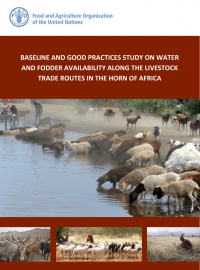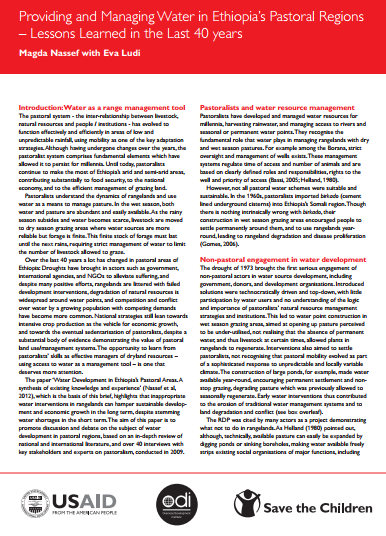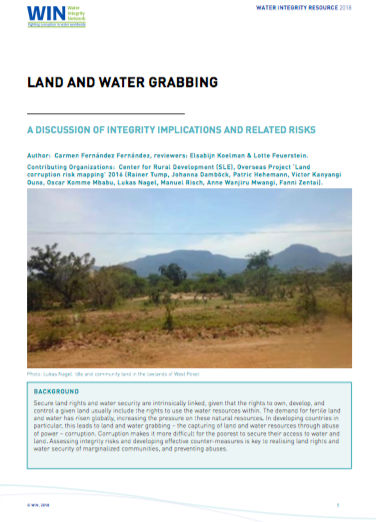Water security amongst impoverished households in the Sundays river valley municipality: community experiences and perspectives
Water security is influenced by the complex interplay between ecological, socio-political, governance and water management systems. Achieving water security is essential for ensuring sustainable development, and challenges with water security are closely linked to the overall experience of poverty that many countries throughout the world, including South Africa, confront. These problems can broadly be understood through three main factors: water availability, access and usage; water governance and management underpin these factors.
Water for Livestock
The first phase of the “Water for Livestock in Isiolo and Garissa Counties, Kenya — Enhancing water resource and rangeland management community capacity through training and strategic water development” has been implemented in in the arid and semi-arid lands of Kenya by IUCN, the Kenya Red Cross Society, and Adeso, with the support from the Swiss Agency for Development and Cooperation. The overall objective of the pilot phase of the project was to improve livelihoods and resilience against drought for targeted communities in North Eastern Kenya.
Water and fodder availability along livestock trade routes in the Horn of Africa
TOPIC GUIDE: Governance of Natural Resources
This topic guide for government agencies, service providers and other practitioners examines various dimensions of governance that are key to deliver appropriate benefit-sharing, ensure sustainable exploitation, minimise conflict over access and control, and maximise the contribution of resources to economies. This includes decentralised and collaborative governance, multi-level and adaptive governance, and the roles of institutions and politics.
Providing and Managing Water in Ethiopia’s Pastoral Regions – Lessons Learned in the Last 40 years
Introduction: Water as a range management tool The pastoral system - the inter-relationship between livestock, natural resources and people / institutions - has evolved to function effectively and efficiently in areas of low and unpredictable rainfall, using mobility as one of the key adaptation strategies. Although having undergone changes over the years, the pastoralist system comprises fundamental elements which have allowed it to persist for millennia.
Irrigation, sécurité alimentaire et pauvreté – Leçons tirées de trois grands barrages en Afrique de l’Ouest
Date: Septembre 2017
Source: Foncier & Développement
Par: Frédéric Bazin, Ibrahima Hathie, Jamie Skinner, Jérôme Koundouno
Ce nouveau rapport GWI synthétise les résultats de quatre années de recherches sur trois barrages et périmètres rizicoles existants : Sélingué au Mali, Bagré au Burkina Faso et Anambé au Sénégal.
Land and Water Grabbing
IN’s latest resource is an introduction to the topic Land and Water Grabbing: A discussion of integrity implications and related risks, which discusses the integrity implications and risks of land and water grabbing. The essay examines the link between land and water grabbing, the people that are most impacted by this, and legal frameworks related to both land and water rights. Land and Water Grabbing describes the impacts of land and water grabbing in Kenya and Ethiopia.
Spatial Modeling of Soil Erosion Risk and Its Implication for Conservation Planning: the Case of the Gobele Watershed, East Hararghe Zone, Ethiopia
Soil erosion by water has accelerated over recent decades due to non-sustainable land use practices resulting in substantial land degradation processes. Spatially explicit information on soil erosion is critical for the development and implementation of appropriate Soil and Water Conservation (SWC) measures.The objectives of this study were to estimate the magnitude of soil loss rate, assess the change of erosion risk, and elucidate their implication for SWC planning in the Gobele Watershed, East Hararghe Zone, Ethiopia.
Groundwater Irrigation Management and the Existing Challenges from the Farmers’ Perspective in Central Iran
The sustainable management of natural resources, and particularly groundwater, presents a major challenge in arid regions to ensure security of water supply and support agricultural production. In many cases, the role of smallholder farmers is often neglected when managing irrigated water and land processes.
Assessing Riparian Vegetation Condition and Function in Disturbed Sites of the Arid Northwestern Mexico
Transformation or modification of vegetation distribution and structure in arid riparian ecosystems can lead to the loss of ecological function. Mexico has 101,500,000 ha of arid lands, however there is a general lack of information regarding how arid riparian ecosystems are being modified.








